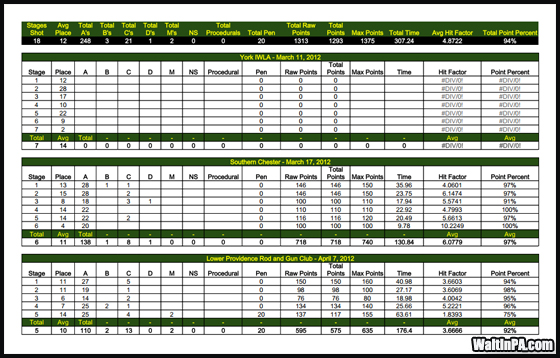
When I was a kid, growing up in Philadelphia, we used to play a lot of urban sports (I suppose thats what they would be called these days). In my neighborhood we didn’t have a lot of parks or sports specific places to go. As a result, we played pretty much everything in parking lots.
In the Spring and Summer we gathered in the old Core States Bank rear parking lot and played Stick Ball. In the late Summer and Fall we played Roller Hockey in that very same parking lot. In the Winter we played Touch (and in the snow, tackle) Football in, you guessed it, that very same parking lot.
No matter what the sport, the neighborhood kids always tracked their stats throughout the season. Being kids, those stats always grew to imaginary proportions by the end of the season and it was tough to know what you really did. After all, it was very informal and records were kept by memory only.
I’d be lying if I told you that I never swelled those stats just a bit to impress a friend. Even so, I used to love keeping a mental tab of how many goals I scored, homeruns I hit, or touchdown passes I caught. I’ve always been a fairly competitive person but things get fierce when I’m competing against myself.
When I started shooting USPSA last season, I fell in love. Not only was it a joy to get out to the range and put rounds on target, I loved comparing my latest match to my previous match. Unlike in my youth, statistics mean more than impressing a friend. I’m dedicated to improving and want to be able to sit down and literally see how I performed in one match versus another.
My first plan was to simply take a video camera to each match and record my performance. When I came home from that I match I would play the video back and take a closer look at how I performed. Coupling that video with USPSA Match Results, I was able to see a lot of things that I wasn’t aware of while shooting in real time.
Early USPSA Stats
In December of 2011, the USPSA Season in Pennsylvania came to a close. With no weekend matches to occupy my time, I turned to reading up on the sport and designing stages to keep my head in the game. While I immersed myself in blogs and forums, a friend and shooting buddy turned his attention to finding a team sponsor.
One day this friend and I got together at a local diner for coffee, and to my amazement, I learned that we had a sponsor. An even larger surprise was that the team, who I had only shot with handful of times, wanted me to be the captain. I accepted the role and can remember thinking ‘Oh man, these guys don’t know what they are getting themselves into with me as Team Captain.’
My completely anal personality kicked into high gear and I went over each team members USPSA Stats with a fine tooth comb. I spent hours with dozens of browser tabs open, comparing individual stage USPSA Results for each shooter. I threw out time and looked at accuracy, I threw out accuracy and looked at only time. The numbers fascinated me but I couldn’t go through the 2012 season in this fashion.
In February I listened to Julie Golob’s podcast and had one of those ‘Oh, Duh!’ moments when she discussed putting together a spreadsheet for shooter statistics. I immediately opened up Google Docs and built a simple spreadsheet to track my personal match results. When I was finished, I created another spreadsheet to track the team results.
The spreadsheet I put together was crude but it allowed me keep tabs on the points earned, points percentage, number of shooters in the division, the shooters ranking, and the shooters placement in terms of percentage. As a personal goal I wanted to be in the top 50% of shooters, on average.
After filling in most of the information, the spreadsheet did a quick calculation and I could get a visual of how the team performed compared to each other.
New USPSA Stats
Over the past couple of months I have been spending a fair amount of time reading the Brian Enos Forums. One of the members posted a question in the New Shooters forum that caught my eye. The shooter wanted to now which was better, a Slow A or a Fast C. I began reading the thread and found a response that was fascinating.
ErichF on the Brian Enos Forum
Shoot slow, MOVE fast. Faster shots will come naturally. Aim for a 85-90% available point score. If you’re shooting 70% of points, you’re going too fast (or your accuracy has real issues), if you’re getting 95% of points, your going too slow.
Because I was pouring over my match scores when they were posted, I knew that I was achieving the majority of the possible points as of late. To be sure, I would need to do some calculations. This gave me an idea for tracking stage by stage results, rather than the broad match results.
I popped open my Google Docs Spreadsheet and created a new page. In this new page I incorporated most of the individual stage results columns from the USPSA Match Results. With this information, I could do a couple of calculations and get a better picture of how I was performing at each match.
When I was finished, I felt like a kid again. Suddenly I had a virtual sports card with running stats from each match. Before long, I was incorporating the same individual stage results to the teams USPSA Stats spreadsheet. The numbers it generated were fascinating.
My 2012 Stats Stat Sheet
As you can see, the sheet is incomplete (the York IWLA Results from last month haven’t been posted on the USPSA Website) and it is going to require some effort to keep everything up to date. I’m no whiz when it comes to spreadsheets, so I need to alter some of the formulas that generate my season average and totals as I go, but I’m very happy with the results.
After each match I now have video of my performance, as well as USPSA Stats, to stare at. I feel like I’m in some sort of Geeky USPSA Heaven.
Do You Track Your Competitive Shooting Stats?
2 thoughts on “USPSA Stats: Tracking My Performance”
Comments are closed.
Recent Posts
When most people think about Motorcycle Group Rides, I believe it conjures up images of large packs of Harley Davidson Motorcycles riding for a cause. While there is no shortage of these types of...
On June 18, 2023, I went for a Father's Day Motorcycle Ride to Lancaster, PA, to see a historic covered bridge. I was stopped at a traffic light at the intersection of PA Rt 422 East and PA Rt 82...

Oh, boy. This so appeals to my inner nerd.
I already have a spreadsheet tracking 17 years of GSSF, may as well expand to USPSA. I like the way you track A, B, C, D, M shots as well as total stage score. It’s a good way to be sure you are within the “EricF Zone.”
Um… Wow I think I’m worried!!! hahah